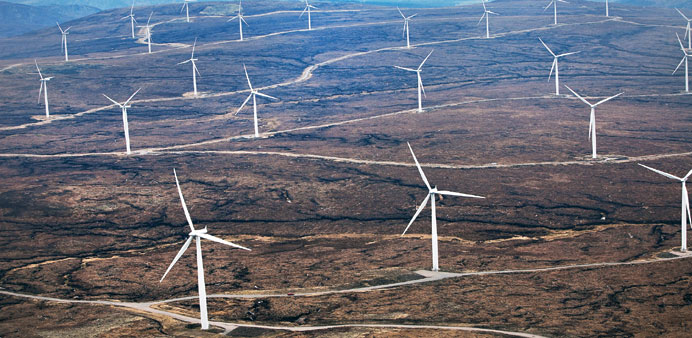Siemens, the world’s No3 maker of wind turbines, expects the global wind power market to more than quadruple by 2030, lifted by strong growth in Asia.
“The market will shift away from Europe significantly,” Markus Tacke, chief executive of the German company’s Wind Power division, said at a renewable energy conference in Berlin.
He said globally installed wind power capacity would increase to 1,107 gigawatt (GW) in 2030 from 273 GW in 2012, with Asia and the Pacific region accounting for more than 47% of the total, up from 34% now.
China is pumping billions of euros into wind power, which is more cost-competitive than solar energy and partly able to compete with coal and gas. Wind power subsidies in most parts of Europe are being slowly scaled back.
The Europe and the Middle East (EMEA) region is still the world’s largest wind market, with a 40% share that will decline to 34% by 2030.
Siemens Wind Power, part of the group’s Energy division, achieved sales of €3.555bn ($4.76bn) in the first nine months of Siemens’ fiscal year, down 1% year on year. It accounted for 6.4% of the company’s total sales.
Its profit margin for the period stood at 3.6%, down from 4.7% a year earlier, as the company was forced to book charges because of problems relating to some of its wind turbine rotor blades.
Meanwhile, Norway’s oil and energy ministry has said it has granted licences to build eight wind power farms with a combined 1,300-megawatt capacity in a major boost for wind power development in the Nordic country.
The ministry said yesterday investment into newly-licensed wind farms was expected to come to around 20bn crowns ($3.32bn), one of the largest investments ever on its mainland.
Norway gets most of electricity from hydro power plants and has 775 MW of installed wind power, far less than neighbouring Sweden, even though it enjoys stronger winds blowing from the Atlantic.
The two countries launch a market-based renewable support scheme last year, aiming to increase production from such sources as wind, small hydro, bio and solar by 26.4 terwatt-hours (TWh) per year by end-2020.
The eight newly approved projects in Norway could contribute up to 3.7 TWh to this goal, the ministry said.
Licences were issued to Norwegian companies SAE Vind, Sarepta Energi and Zephyr, which counts Denmark’s Dong Energy as a stakeholder, to develop wind power farms around the city of Trondheim, an area with a power deficit.
The oil and energy ministry has also issued a licence to state-owned transmission grid operator Statnett to build a new 420kV power line to connect the wind farms.
“Obviously it’s a huge project to undertake. We are talking about 450 turbines and about 200km of high-voltage lines to be built,” Andreas Thon Aasheim at the Norwegian wind power association Norwea told Reuters.
Sarepta Energi, which is owned by power companies TroenderEnergi and NTE, said it planned to invest up to 10bn crowns into what it called the largest onshore wind farm development in northern Europe.
Companies were expected to make the final investment decisions in 2015, and the first wind turbines in the area should be up and running in 2018, said Aasheim.
Long licensing procedures, lack of power lines and higher costs were partly blamed for slower wind power development in Norway compared to Sweden, which had 3,607MW of installed wind capacities by end-2012 generating 7.2 TWh.
Including the newly licensed projects and the existing plants, Norway was expected to have up to 3,000MW of wind power by end-2020, Aasheim said.



